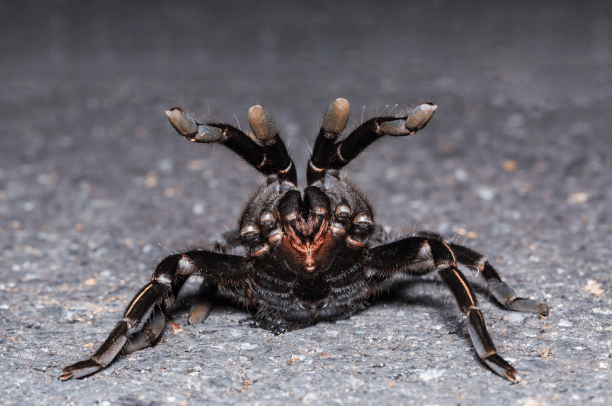Thai Tiger Tarantula (Everything You Need To Know)
Common Names: Thai tiger tarantula, Thailand tiger tarantula, Tiger tarantula
Scientific Name: Cyriopagopus paganus
Features
The Thai tiger tarantula species belongs to the tarantula family (Theraphosidae). The species is found throughout Southeast Asia’s central region as per its common name.
The tarantula’s name is based upon the fact that it is virtually entirely black. The carapace appears to be elongated and arched. It shimmers moss green on freshly skinned animals.
Description
This tarantula is a member of the subfamily Ornithoctoninae, commonly referred to as ‘earth tigers.’ The Thai tiger tarantula is a fast-moving, aggressive spider that lives in burrows in the ground. They bite as they feel threatened and have a significant amount of venom.
Fortunately, their bite is harmless to humans unless the individual is allergic.
The Thai tiger tarantula can grow up to 15 cm (6 inches) in length and weighs approximately 42 g, with males somewhat smaller than females. They are entirely black and do not become brown before molting. After hatching, these tarantulas may lose as many as six times during their first year; they then molt just once a year.
The max leg span is 130 millimeters. As a result, the Thai tiger tarantula is classified as a medium-sized member of the family.
Physical Appearance
This species is all black except for the chevron marks on the abdomen. This species can reach a diameter of 15cm (6inches). Males are a little bit smaller than their female counterparts.
Habitat
Thai tiger tarantulas live in caves. These spiders, recognized as “tiger tarantulas,” are prevalent in Southeast Asian woods.
The Thai tiger tarantula’s range includes tropical rainforests affected by monsoons. In addition, these species live in forests, for which they are often seen on the forest floor.
They use silk to construct burrows in the ground or behind the old tree bark. This silk is shaped into tubes that allow tarantulas to feel vibrations and determine when prey is nearby.
Distribution
This tiger tarantula can be found in tropical rainforests in Myanmar, Thailand, and other countries.

Longevity
Males have a significantly shorter lifespan than females since almost all spiders have. Males often live less than three years and perish shortly after sexual maturity. On the other hand, females can easily live for 10 to 12 years.
Tiger Tarantulas as Pets
Tarantulas are popular as pets for many people. Unfortunately, they typically keep just the considerably more docile and friendly new world tarantulas. Thai tiger tarantulas are ancient world spiders that are significantly more dangerous and aggressive than other spiders.
Only those familiar with handling and caring for tarantulas should keep Thai tiger tarantulas. They are not suitable for children.
These are recommended for advanced keepers only.
Caging
This species should be kept in a 5 to 8-gallon enclosure as adults. Slings should be kept inside a pill bottle and then moved to a deli cup when they mature. To avoid tarantulas crawling to the top of their enclosure and getting their tarsus caught, it is recommended that they do not have mesh tops.
If they do, they may lose one of their legs. Tarantulas can climb and fall, and even a few inches of a fall can be fatal to them, so much substrate is required. Since this species makes deep caves, a higher elevation is needed.
Enclosure Decor
There is no need for enclosure decoration; a piece of bark can be used as an initial burrow but is not necessary.
Temperature
The ideal temperature range for this Thai tiger tarantula is between 78° and 84°F.
Lighting and Heat
This species does not require lighting or heating when the temperature in the house remains between 75 and 85 degrees. However, you should use a compact portable heater if the temperature in your home falls below that level.
Water and Humidity
Humidity should be maintained between 70% and 80%. Two times a week, you should moisten about half of the substrate. This will help keep the humidity level high enough. A small dish can be used as a water bowl for an adult and a bottle cap for a juvenile specimen. Freshwater for drinking should be readily available at all times.
What Food Do Thai Tiger Tarantulas Consume?
The Thai Tiger tarantula species are opportunistic carnivores. These tarantulas lurk outside their burrow at night, waiting for prey to come their way. These tiger tarantulas prefer places with an abundance of food sources.
So, they do not require to hunt. Instead, they will sit still outside their burrow at night, watching for passing prey. Their primary food sources include insects, lizards, and small birds.

Despite their eight eyes, tarantulas, like most spiders, do not have excellent vision. As a result, they cannot see their prey approaching, but they can detect it through vibrations. They utilize silk tubes in the structure of their burrows. The spider waits at the burrow’s entrance and receives small pulses via these tubes. The vibrations become more significant as the prey approaches closer, signaling the tarantula to strike.
This species can eat crickets and other insects of an appropriate size.
Supplements
Tarantulas do not require any additional supplements.
Breeding
Because this species is rarely bred in captivity, most specimens available for sale are field collected. To produce, you must have a healthy male and an adult female. After placing the male inside the female’s enclosure, assuming all goes according to plan, he will use his tibial hooks to grasp the female’s fangs and release the sperm into the female.
If you don’t separate them after mating, the female may try to consume the male. The female will create an egg sack if the breeding is successful. When the time comes, you will need to collect the female’s egg sack, place it in an incubator, and then release the egg sack once it is ready. Then, the slings must then be separated and stored in their containers.
Taking care of your new pet
This species is speedy and will bite without hesitation. If irritated, this species will bite many times and produces venomous stings.
Most of this species’ existence is spent underground, and it emerges from its burrow only at night to search for prey.
Toxicity of Venom
Thai tiger spider bites are venomous but not dangerous. However, some people experience intense pain, sweating, muscle agony, vomiting, headaches, and giddiness when bitten.
Are Thai Tiger Tarantulas Extremely Toxic?
The Thai tiger tarantula prefers to dwell in underground tunnels, is extremely fast, and is quite aggressive. They bite when they feel danger and possess quite a potentially toxic substance. Fortunately, their bites are not lethal to humans unless the person is allergic.
Is It True That Thai Tiger Tarantulas Are Climbers?
This species grows to a maximum length of 5 inches, with males being slightly longer than females. This Thai tiger tarantula species can be found in tropical rainforests in Myanmar, Thailand, and other countries. Additionally, high substrate levels are recommended since tarantulas climb and fall, and a fall of a few inches can be lethal.
Related Posts
- Brazilian Blue Tarantula (Everything You Need To Know)
- Thailand Black Tarantula (Everything You Need To Know)
- Thai Tiger Tarantula (Everything You Need To Know)
- Feather Leg Baboon Tarantula (Everything You Need To Know)
- Blue Baboon Tarantula (Everything You Need To Know)
- Trinidad Olive Tarantula – All Facts
- Purple Bloom Tarantula – All Facts
- Brazilian Jewel Tarantula (All Facts You Need To Know)
- Mink Vs. Ferret – All You Need To Know
- 25 Small White Dog Breeds For a Pet






